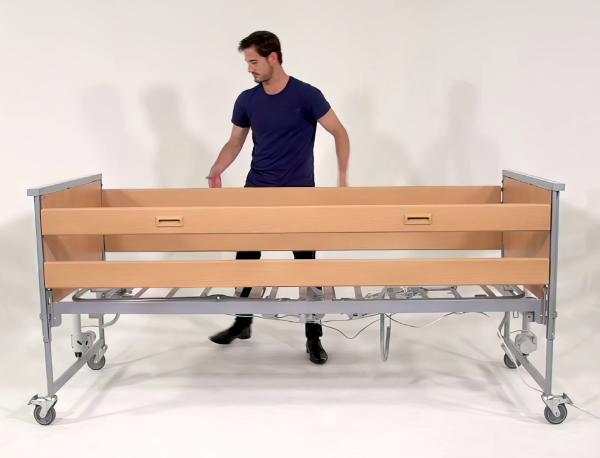Things to Think About Before Committing to a Bed
Tips for hiring a hospital bed: When selecting a hospital bed for home use, consider the patient’s medical needs and the type of bed that suits them, choose a reputable provider, ensure safety standards, prioritise comfort features, budget wisely, and maintain the bed properly. These steps ensure optimal care and comfort for your loved ones at home.
Choosing and Hiring a Medical Bed
Hospital beds for home use have become an essential part of home healthcare, providing support for patients who need medical care in a comfortable and familiar environment.
The goal is simple yet significant: ensuring your loved one feels safe and comfortable.
This guide will help you navigate the process of choosing and renting the right hospital bed so you make an informed decision that meets all your needs.
Here are our tips for hiring a hospital bed.
Tip 1: Assess Your Needs
Before choosing a hospital bed, it’s essential to evaluate the specific requirements of the patient and the home environment.
Medical Requirements: Start by evaluating the specific health conditions and mobility issues of the patient. Different medical conditions require different types of support. For example, a patient with limited mobility might need a bed with advanced adjustability features.
Space Considerations: Measure the available space in the room where the bed will be placed. This ensures the bed fits comfortably without obstructing movement or other essential furniture.
Caregiver Accessibility: The bed’s design should allow easy access for caregivers to assist the patient. Features like adjustable height can significantly ease the caregiver’s task, making daily care routines less physically demanding.
Tip 2: Explore Bed Types
The next of our tips for hiring a hospital bed is to know your options.
Understanding the different types of hospital beds can help you choose the one that best suits your needs and budget.
Manual Beds: These are cost-effective but require physical effort to adjust. They are suitable for patients with limited needs and where budget constraints are significant.
Semi-Electric Beds: These beds offer electric adjustments for the head and foot sections but require manual height adjustment. They provide a good balance between functionality and cost.
Full-Electric Beds: These beds are fully adjustable and have electric controls for maximum convenience. They are ideal for patients who need frequent adjustments or need to be moved to slightly different angles every so often.
Tip 3: Choose a Reliable Provider
Selecting a reputable provider ensures you receive quality products and dependable service.
Reputation: Look for providers with positive reviews and a solid track record. A reputable provider ensures quality products and reliable service.
Delivery and Setup: Confirm if they include delivery, setup, and bed usage training. Proper setup and understanding of the bed’s features are crucial for safety and functionality.
Customer Support: Check for responsive customer service for support. Reliable customer support can be a lifesaver in case of any issues with the bed.
Tip 4: Check Quality and Safety Standards
Making sure the bed meets quality and safety standards is important for the patient’s well-being and security.
Certifications: Check that the bed meets relevant safety and quality certifications. This guarantees that it has been tested and approved for medical use.
Durability: Look for beds made from high-quality materials that can withstand regular use. Durable beds are essential for long-term care and reduce the need for frequent replacements.
Safety Features: Essential features include side rails, emergency power backup, and secure locking mechanisms. These features prevent accidents for patient safety.
Tip 5: Make it Comfortable and Convenient
Comfort and convenience are key to the patient’s recovery and overall experience.
Mattress Options: Consider the type of mattress (e.g., foam, air) for pressure relief and comfort. The right mattress can prevent bedsores and enhance the patient’s comfort.
Adjustability: Ensure the bed offers necessary adjustments for head, foot, and height positions. Adjustability is crucial for both patient comfort and caregiver convenience.
Additional Accessories: Look for features like overbed tables, trapeze bars, and side rail pads for added convenience. These accessories can make daily activities more manageable for both patients and caregivers.
Tip 6: Budgeting and Financing Options
Exploring financial options can make acquiring a hospital bed more affordable.
Financial Assistance: Explore programs and grants available for home healthcare equipment. Various organisations offer financial aid to make medical equipment more affordable.
Payment Plans: Ask about instalment plans or financing options to spread out the cost. This can make the investment more manageable, especially if insurance does not cover the costs.
Tip 7: Maintain and Care for the Bed
Proper maintenance is essential for the bed’s longevity and safe use.
Regular Cleaning: Follow the manufacturer’s guidelines for cleaning and disinfecting the bed. Proper hygiene is essential to prevent infections and maintain a healthy environment.
Provider Support: Use the maintenance services offered by rental companies to keep the bed in optimal condition. Regular maintenance checks by professionals can keep the bed safe and functional.
Final Thoughts
Selecting the right hospital bed for home use is a decision that can significantly impact your loved one’s comfort, safety, and well-being.
If you’re not sure what you need, it’s a good idea to ask for some help.
Provide the best comfort and care for your loved ones with a hospital bed from Home Care Hire.
Explore our hospital beds and mattresses, or contact us to speak with a specialist and find the perfect solution for your needs.
